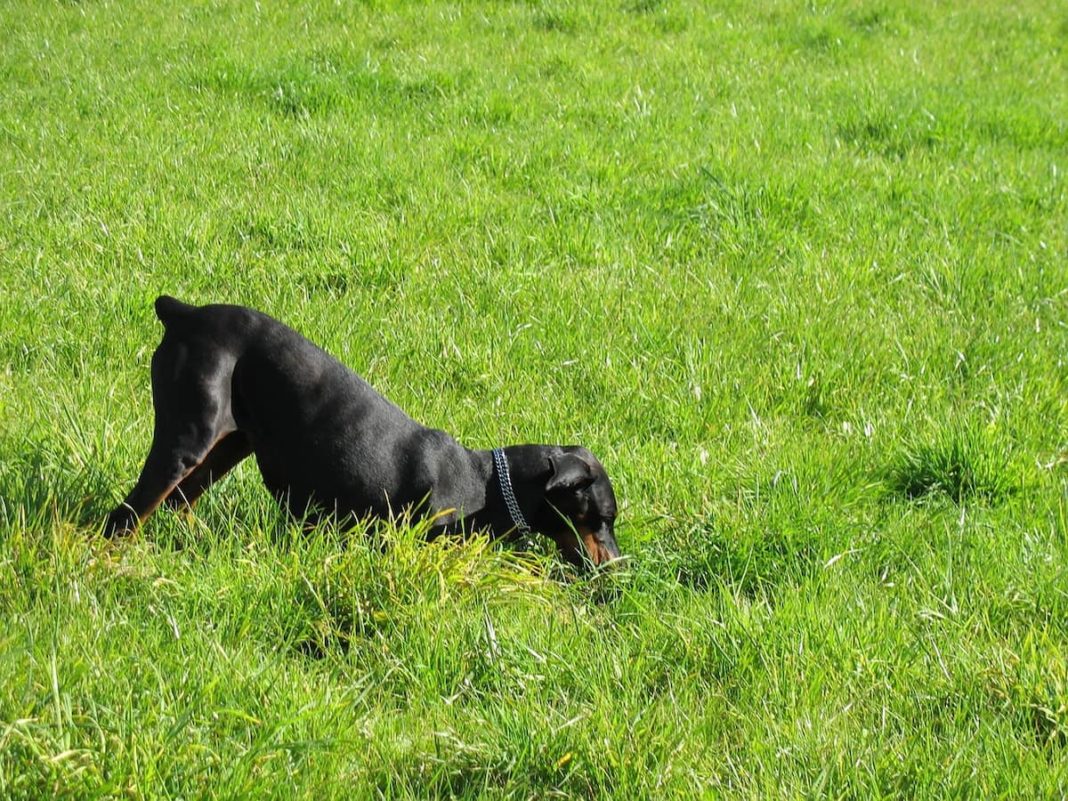Quicklinks:
- Why Would My Dog Want To Eat A Frog?
- How To Stop Your Dog From Eating Frogs?
- My Dog Ate A Frog?
- My Dog Ate A Frog—What Should I Do?
- Symptoms To Look Out For
- When Should You Call The Vet?
Why Would My Dog Want To Eat A Frog?
We all know how inherently curious our dogs are. So, the movements and noises of a frog can be quite irresistible to a dog.
Most dogs probably won’t eat frogs because they’re hungry, so it’s more likely that they’ll have ended up ingesting the toxins from a frog by either trying to lick or mouth the frog in an attempt to play.
Many types of frogs and toads burrow and live under the shelter of leaves in your back yard/garden. Considering how well our dogs love to dig, it’s probable that your dog will come across a frog or toad when they are going about their daily adventures in the backyard is high.
How To Stop Your Dog From Eating Frogs?
Short of locking your dog inside all day, there are very little dog owners can do to guarantee that their dog won’t ever come into contact with a wild frog. Especially if you live in an area where wild frogs or toads are common.
If you live in an area with lots of toads and frogs, it’s good to try to get to know where they tend to burrow and the time of day when they are most active.
It may be a good idea to restrict your dog’s access to these areas during the times when the frogs and toads are likely to be hopping around the garden.
Most poisonings happen in the evening when frogs and toads are more active and dogs are playing in the yard.
My Dog Ate A Frog?
While it certainly helps to know what species of frog and toad live in your area, you defiantly don’t need to become an expert on the topic to treat your dog if they were to eat a frog. Remember that not all frogs and toads are poisonous, however, there are some that are highly toxic or can carry parasites that could go on to infect your dog. It’s for these reasons that you need to know what to do and by knowing some basic first aid.
Even if you think the species of frog is harmless, it’s still a good idea to call your local vet for advice. If your dog seems unwell, the first thing that you need to do is to take your dog to the vet as soon as possible.
Unfortunately, as frogs and toads can be very appealing to a dog—something that jumps like a frog will look like a whole lot of fun to a dog, especially if the dog has found the frog while digging!
Stopping your dog from eating frogs could be a challenge, but still having an action plan in place, just in case, is definitely a must, particularly if your dog has a weakness for frogs.
My Dog Ate A Frog—What Should I Do?
If your dog brings what is left of the frog to you as a gift, then you need to try taking it out of their dog’s mouth. It’s also important to try to stay calm, so when you’re removing the frog or toad from your dog’s mouth doesn’t become another issue of its own!
Next, you need to wash your dog’s mouth. To remove any chemicals from the dog’s mouth, carefully wash out your dog’s mouth with water, while being gentle enough to not encourage the dog to inhale the water. That doesn’t mean squirting water down your dog’s throat, which will only spread the toxins further down their digestive tract. Instead, dampen a cloth and wipe the inside of your dog’s mouth and gums. Make sure to rinse the cloth thoroughly between each wipe. Keep doing this for around 10 minutes. If the frog is poisonous, this would help to remove some of the toxins before they are absorbed into the dog’s system.
Often, the toxins that are excreted from frogs and toads are quite sticky, so wiping out your dog’s mouth may be quite effective in reducing the effect of poisoning.
Then, if possible, collect a sample of the offending frog and get it to your local vet. It’s important to give your vet as much information as possible about your dog. It’s important to take note of any symptoms and the order in which they appeared. You’ll also need to let your vet know about any pre-existing conditions your dog has and any medications they are on as well.
Symptoms To Look Out For
It’s quite common for a dog to froth at the mouth if a dog has ingested or even just licked a frog or toad. Frothing is a natural cleaning mechanism; frothing happens to help get rid of the toxins.
Although the dog is not necessarily about to die, nevertheless administering first aid quickly is still vital. This will lessen the chances of your dog from severe poisoning or death. Symptoms will vary according to the exact toxin a particular frog or toad produces, as well as the amount your dog has ingested.
Other symptoms include:
- Looking dazed
- Bright red gums
- Shaking
- Seizures
- Abnormal heart rhythm
- Difficulty breathing
- Collapse
If you’re unsure how severe the situation is, call your local vet and describe the dog’s symptoms. They’ll be able to advise you on first aid treatments, and further symptoms to look out for, and what you should do next.
When Should You Call The Vet?
If your dog starts to show signs of becoming ill, immediately start to administer first aid and remember that seeking medical help is more important than collecting a “sample” of their amphibian victim.
Even if you’re sure the frog or toad is not poisonous, it’s still a good idea to get in touch with the vet to describe the symptoms. Your vet can help you decide on the best course of treatment, even if they don’t need to see your dog in the clinic.
Frogs can also carry parasites, which could also be infectious for dogs. Therefore, it’s good for your vet to know that your dog has eaten a frog or toad. This can be important when diagnosing. any future infections that could become a problem.








